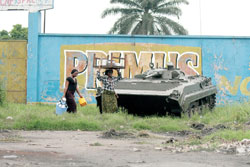The Capital of Rape: Fighting Widespread Sexual Violence in the Democratic Republic of the Congo

Congolese women walk past one of four tanks
stationed—along with soldiers—in the area to
preserve order in the wake of a contested
presidential election in November.
Photo by Junior D. Kannah/APP/Getty Images
Rape has become a tragic fact of life for many women in the Democratic Republic of the Congo. Human rights experts say sexual violence has been one of the defining characteristics of the brutal conflict that erupted in the DRC in the mid-1990s, when a civil war in neighboring Rwanda spilled over its borders. Estimates put the death toll in the DRC as high as 5.4 million people, making it the deadliest conflict since the end of World War II. Various peace accords have been brokered starting in 2003, but the violence has persisted, especially in the eastern part of the country.
The United Nations estimates that some 500,000 people have been raped or subjected to sexual violence since the conflict erupted in 1996. Some attacks have targeted boys and men, but the vast majority of victims have been women and girls. A paper published last year in the American Journal of Public Health suggests that the incidence of rape in the DRC is even higher than the U.N. estimates and spreading beyond conflict zones.
“Regardless of the victim’s gender, rape is used as a weapon of war,” states an article by Michael Maya on the website of the ABA Rule of Law Initiative. “It has proven to be remarkably effective, destroying not only the lives of its victims but also their families and sometimes entire villages. Particularly in the case of girls and women, rape survivors are frequently rejected by their families and communities,” states Maya, the initiative’s deputy director. He directed its programs in Africa from July 2007 until February 2011.
A growing concern is that rape and other types of sexual violence are becoming more prevalent throughout the DRC. “Initially, rapes were almost entirely restricted to conflict zones and committed by armed combatants,” states Maya in his article. “With each passing year, however, more and more rapes are being committed by civilians, some of whom are former soldiers who continue to rape upon returning to their villages and cities as noncombatants.” Sexual violence between intimate partners also appears to be on the rise.
Click here to read the rest of “The Capital of Rape” from the February issue of the ABA Journal.



